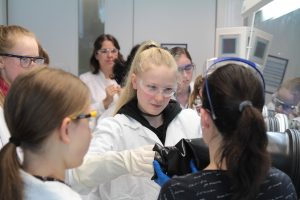
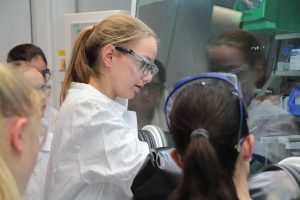
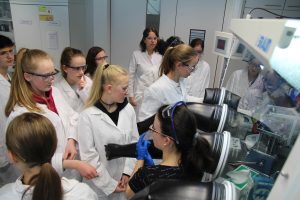
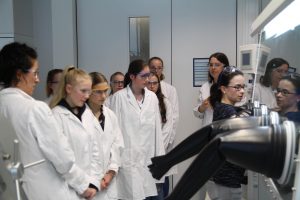
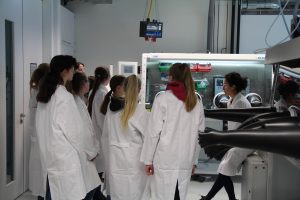

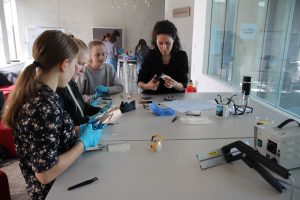
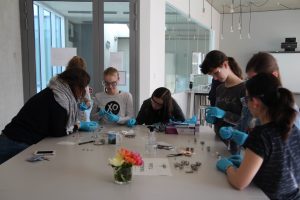
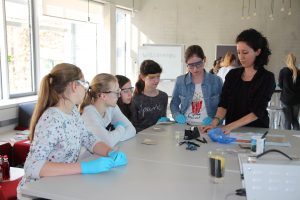
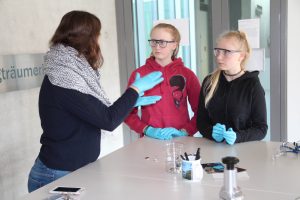
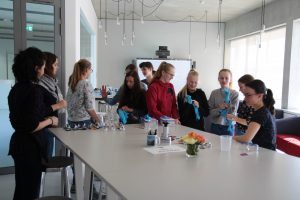
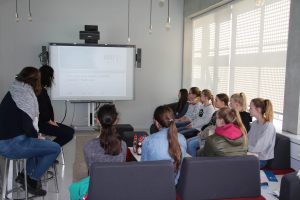
From 23 to 25 January 2019, the Kompetenznetzwerk Lithium-Ionen-Batterien (KLiB) organized the Batterieforum Deutschland with the support of the Federal Ministry of Education and Research (BMBF). For the seventh time already, the interdisciplinary and cross-sector scientific-technical congress brought together scientists from university and non-university research institutions, industry and politicians to develop an interdisciplinary understanding of batteries through dialogue.
On the first day, invited speakers from industry, science and politics looked at the topic of batteries in Germany from different perspectives. On the following two days, current scientific and technical focal points were discussed. Prof. Maximilian Fichtner, Vice Director of the HIU, moderated the topic block “Raw materials – availability and market scenarios”. Dr. Timo Danner from the Electrochemical Multiphysics Modelling Group presented his results on the production and simulation of high-capacity, structured electrodes and Dr. Marcel Weil, Group Leader of Resources, Recycling, Environment & Sustainability, outlined scenarios for resource requirements for energy storage until 2050.
The 25 research group leaders and other responsible persons of the new cluster of excellence, which bears the name POLiS (Post Lithium Storage), met at HIU to set the course for a fast and successful start of the research work. Prof. Joachim Ankerhold, Vice President of the Ulm University, emphasised in his welcoming address how well the two locations Ulm and Karlsruhe complement each other in their specialisations in battery research and highlighted the HIU as the first successful example. Prof. Maximilian Fichtner, who was elected spokesperson of the cluster of excellence, reminded the audience that of a total of five applications from battery research, only the POLiS application survived the first round of applications. Due to the large number of research groups and new projects, the cluster employees will move into a new research building on the campus of the Ulm University in March.
The cluster’s research concentrates on so-called post lithium batteries, i.e. batteries that run completely without lithium. One reason for this is that the maximum storage capacity of conventional lithium-ion batteries is nearly reached. Also, the extraction of the constituents – such as cobalt, graphite, and lithium – carries political, environmental and economic risks. A scarcity of resources and the uncertain political situations of some countries with large repositories could lead to supply disruptions. Also in many cases, the extraction of e.g. cobalt is associated with high environmental impact. In order to achieve progress in performance and make batteries more sustainable, the development of new, alternative storage materials and concepts must be driven forward. The cluster’s electrochemists, materials scientists and modellers are studying sodium, magnesium and aluminium as alternative charge carriers. The aim is to cover the entire development chain of a battery, from basic material research to technology transfer.
At the end of September last year, the Federal Minister of Education and Research, Anja Karliczek, approved the joint application for a cluster of excellence of the Karlsruhe Institute of Technology (KIT) and the University of Ulm, together with the Centre for Solar Energy and Hydrogen Research Baden-Württemberg (ZSW) and the University of Gießen.
For the first time, a research group successfully uses eggshells as an electrode for energy storage
Biowaste in the form of chicken egg shells proves to be very effective for energy storage. In the journal Dalton Transactions, of the Royal Society of Chemistry, scientists present the sustainable storage material that could make a low-cost lithium ion capacitor possible.
Chicken eggs are used worldwide in large quantities in the food, pharmaceutical, and manufacturing industries, and for household purposes. However, after the egg is used, the shells are discarded and disposed of as bio-waste in landfills. The shell consists of a composite of calcium carbonate (CaCO3) and a protein-rich fibre membrane. “Surprisingly, there are always new examples in which natural substances have good to very good prerequisites for producing materials for electrochemical storage,” explains Professor Maximilian Fichtner from the Helmholtz Institute Ulm, a KIT-supported institution.
Together with his Australian colleagues, Fichtner discovered the promising electrochemical properties of chicken egg shells, which are able to store lithium well due to their high CaCO3 rate. The fine eggshell powders are used as an electrode against a metallic lithium anode in a non-aqueous electrolyte. Thereon, the cell maintained an excellent capacitance retention of 92% over 1000 cycles. Both the calcified shell and the shell membranes, including the inner and outer membranes, were used from the egg shells. The researchers washed, oven dried and crushed the shells to a powder and obtained a conductive material.
Egg shell waste has been used in a number of applications, including bioceramics, cosmetics and the dye industry. At the same time, the protein-rich, fibrous egg shell membrane has functioned as a separator in supercapacitors. Biowaste has now been used as an electrode for the first time worldwide. Further research and a detailed understanding of the electrochemical and physical behaviour of the material is needed in order to improve its performance and to enable its widespread use.
Bio-waste chicken eggshells to store energy.
Minakshi, M.; Visbal, H.; Mitchell, D. R. G.; Fichtner, M.
2018. Dalton transactions, 2018 (47), 16828–16834. doi:10.1039/c8dt03252a
Seven Canadian scientists from the field of energy storage visited the HIU on their European tour. Prof. Stefano Passerini, Director of the HIU, introduced the HIU research activities before giving a tour through the chemistry and physics laboratories. Prof. Joachim Ankerhold, Vice President of the Ulm University and member of the HIU board of directors, welcomed the researchers at the Ulm University with an overview of the science park on the Eselsberg. Prof. Axel Groß also presented the new POLiS cluster of excellence. Further stations of the delegation trip were the KIT and the ZSW – also partner institutions of the HIU.
The Canadian scientists belong to the NEST Network (Energy Storage Technology Network), which brings together researchers in Canada to develop next-generation energy storage technologies. The researchers, who belong to Ryerson University, École Polytechnique de Montréal, University of Waterloo, University of Ottawa and Simon Fraser University, visited several European institutions to explore collaborations within research projects.
Ten girls from the 8th grade used this year’s Girls’ Day on 28 March to take a look behind the scenes at HIU and got to know the work of a battery researcher.












Prof. Stefano Passerini, Director of the Helmholtz Institute Ulm, has now been elected to the Leopoldina, the National Academy of Sciences. Prof. Passerini has been working on the development of materials and systems for electrochemical energy storage for 30 years. His research focuses on the basic understanding and development of materials for lithium batteries, such as ionic liquids, polymer electrolytes and electrode materials. Passerini is the co-author of over 500 publications and for the third year in a row one of the most cited researchers in his field.
The Leopoldina is one of the oldest science academies in the world. Since its foundation in 1652, it is obligated to the advancement of free science, to benefit humankind and to shape a common future. With a base of about 1,500 members, the Leopoldina unites the forces of outstanding scientists from Germany, Austria, Switzerland and numerous other countries. The Leopoldina was appointed the German National Academy of Sciences in 2008. In this capacity, it represents the German scientific community in international committees and assumes a nonpartisan scientific position on social and political issues.
Professor Dr. Maximilian Fichtner reported on the current situation in energy supply at KIT’s Open Day. The focus was on the contribution that batteries can make to the storage of renewable energies and the challenges that have to be mastered in order to implement the energy system transformation in the coming years.
Learning tractors, synthetic CO2-neutral fuels, new technologies for e-mobility, innovative vehicle and transport systems. In addition, there was a knowledge rally for children and a top-class stage programme. KIT presented all this at the Open Day on Saturday, 29 June 2019, which also marked the start of this year’s EFFEKTE science festival in Karlsruhe. 9,000 visitors plunged into the exciting world of science at KIT’s Campus East with hands-on activities, lectures and demonstrations.
Dr. Heribert Wilhelm, Managing Director of HIU, welcomed the 20-strong delegation from Taiwanese representatives from industry, research and administration and informed them about HIU research, the research platform CELEST and the Cluster of Excellence POLiS. Baden-Württemberg International, the economic development agency of the state of Baden-Württemberg, carried out the information trip on the subject of battery-operated traction systems and charging infrastructure, a project of the BMWi’s Energy Export Initiative.
The information trip consisted of visits to German companies and institutions with the aim of informing Taiwanese decision-makers about German technologies and solutions and sensitizing them to their performance. At the same time, the information trip offered a forum for mutual exchange that could facilitate future cooperation.
Energy transition topics are gaining more and more political significance. The discussion about sustainable energy production and reliable supply security often leads to the question: Where could future energy storage systems be deployed and how do they have to perform?
How such a future szenario might look like was debated on September 16th, 2019 by numerous industry representatives at the Helmholtz Institute Ulm (HIU). The energy experts met for the events series “Energy Transition Dialogue” to catch up on current research results of electrochemical energy storage.
Rudolf Scharping, once Prime Minister of the State of Rhineland-Palatinate and Federal Defense Minister of Germany, led the accompanying workshop “Key to Energy Transition – Storage Technologies in Comparison”.
Prof. Dr. med. Maximilian Fichtner, Deputy Director of the Helmholtz Institute Ulm accompanied the workshop scientifically and provided an overview of current research results on electrochemical energy storage.
Scientists at Helmholtz Institute Ulm developed first electrolytes for calcium batteries with acceptable properties at room temperature.
Calcium-based batteries promise to reach a high energy density at low manufacturing costs. This lab-scale technology has the potential for replacing lithium-ion technology in future energy storage systems. Using the electrolytes available, however, it has been impossible so far to charge calcium batteries at room temperature. In the Energy & Environmental Science journal, researchers of HIU now present a promising electrolyte class, with which this will be possible.
Efficient, large, and low-cost energy storage systems will facilitate the transition to zero-emission mobility and power supply nationwide. Today’s predominant lithium-ion technology, however, cannot fulfill this task on a global scale, says Professor Maximilian Fichtner, Director of the research platform CELEST (Center for Electrochemical Energy Storage Ulm & Karlsruhe). Here, calcium batteries and other storage technologies are studied. “In the medium term, lithium-ion batteries will reach their limits in terms of performance and some of the resources used for their manufacture. This will prevent their future use wherever that would be reasonable for the energy transition. Availability of resources needed for manufacture, such as cobalt, nickel, and lithium, is limited.”
At the Helmholtz Institute Ulm Fichtner and his team focus on alternative battery technologies instead. These technologies are based on more abundant resources. Calcium is a promising candidate, because it can release and accept two electrons per atom contrary to lithium and because it supplies a voltage similar to that of lithium: “Calcium is the fifth most abundant element in the earth’s crust. It is distributed homogeneously on earth and it is safe, non-toxic and inexpensive.”
Search for a Suitable Electrolyte
Still, there has been a big obstacle in calcium battery development so far: In contrast to the established lithium-ion technology or more recent sodium or magnesium technologies, practicable electrolytes to produce rechargeable calcium batteries have been lacking so far. “For a few years now, experimental electrolytes and, hence, prototypes of the calcium battery have been available,” says Dr. Zhenyou Li, first author of the study, and Dr. Zhirong Zhao-Karger, who heads the project. Both are working in the POLiS (Post Lithium Storage) Cluster of Excellence at HIU.
“But these electrolytes enable charging at temperatures beyond 75 degrees Celsius only and additionally they are susceptible to undesired side reactions. ”The researchers have now succeeded in synthesizing a class of new electrolytes based on special organic calcium salts. These electrolytes enable charging at room temperature. Using the new electrolyte calcium tetrakis[hexafluoroisopropyloxy] borate, the researchers demonstrated feasibility of calcium batteries of high energy density, storage capacity, and quick-charging capability. Their results are reported in the journal “Energy & Environmental Science”.
Calcium Batteries as Sustainable Energy Storage Systems
The new class of electrolytes is an important basis for transferring calcium batteries from the laboratory to application. In electric vehicles, mobile electronic devices, and stationary storage systems, they might replace the presently predominating lithium-ion battery one day. But this may take a while: “The new electrolytes are a first important step,” Fichtner emphasizes. “There still is a far way to go to the mature calcium battery.”
Zhenyou Li, Olaf Fuhr, Maximilian Fichtner, Zhirong Zhao-Karger: Towards stable and efficient electrolytes for room-temperature rechargeable calcium batteries. Energy & Environmental Science, 2019. DOI: 10.1039/c9ee01699f.